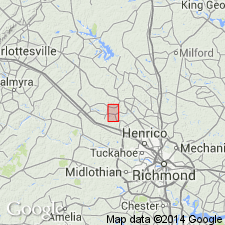
- Usage in publication:
-
- Montpelier Anorthosite*
- Modifications:
-
- Named
- Geochronologic dating
- Dominant lithology:
-
- Anorthosite
- AAPG geologic province:
-
- Piedmont-Blue Ridge province
Summary:
Montpelier Anorthosite formally named. Previously used informally or without expressed formal intent by numerous workers (Bice and Clement, 1982; Beasely, 1983; Glover, 1989, 1992; Farrar, 1984; Marr, 1985; Weems, 1985). Named for community of Montpelier, on north side of South Anna River, Hanover Co., eastern VA. Located at northern end of doubly-plunging antiform cored by State Farm Gneiss. Occurs as 1) coarse anorthosite which is light gray and essentially nonfoliated, and 2) fine-grained granoblastic meta-anorthosite, which is foliated and lineated. Surrounded on all sides by State Farm Gneiss, Maidens Gneiss, and Sabot Amphibolite, a sequence of variably garnetiferous, interlayered hornblende-biotite-plagioclase gneiss, biotite-hornblende-plagioclase gneiss, and amphibolite, and contains inclusions interpreted to be xenoliths of the same gneisses. Field relations suggest that Montpelier intruded this sequence at a depth sufficient to account for lit-par-lit intercalations. Therefore, layered gneiss sequence (regardless of formational names applied) must be older than Montpelier emplacement and crystallization. Montpelier and surrounding gneisses are intruded by metagabbro dikes of premetamorphic but unknown age. Age of the Montpelier is Middle Proterozoic based on U-Pb zircon age of 1045+/-10 Ma (age of crystallization).
Source: GNU records (USGS DDS-6; Reston GNULEX).
For more information, please contact Nancy Stamm, Geologic Names Committee Secretary.
Asterisk (*) indicates published by U.S. Geological Survey authors.
"No current usage" (†) implies that a name has been abandoned or has fallen into disuse. Former usage and, if known, replacement name given in parentheses ( ).
Slash (/) indicates name conflicts with nomenclatural guidelines (CSN, 1933; ACSN, 1961, 1970; NACSN, 1983, 2005, 2021). May be explained within brackets ([ ]).

